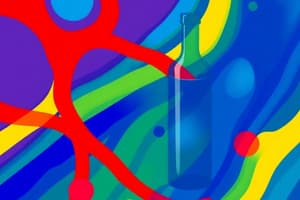Podcast
Questions and Answers
What is the main purpose of fermentation in alcohol production?
What is the main purpose of fermentation in alcohol production?
- To remove impurities from the final product
- To break down plant sugars to produce ethanol (correct)
- To increase the alcohol content by distillation
- To create a carbonated beverage
How is Blood Alcohol Concentration (BAC) defined?
How is Blood Alcohol Concentration (BAC) defined?
- The amount of alcohol consumed per hour
- The overall percentage of alcohol in a beverage
- The measure of alcohol's effect on the brain
- The ratio of the amount of alcohol to total blood volume (correct)
What constitutes binge drinking for men?
What constitutes binge drinking for men?
- Seven drinks in one sitting
- Three drinks in one sitting
- Six drinks in one sitting
- Five drinks in a single sitting (correct)
What is a potential consequence of fetal alcohol syndrome (FAS)?
What is a potential consequence of fetal alcohol syndrome (FAS)?
Which of the following is NOT a typical symptom of a hangover associated with alcohol consumption?
Which of the following is NOT a typical symptom of a hangover associated with alcohol consumption?
Flashcards
Fermentation in alcohol production
Fermentation in alcohol production
The conversion of plant sugars into ethanol, a type of alcohol, through the action of yeast.
Blood Alcohol Concentration (BAC)
Blood Alcohol Concentration (BAC)
The ratio of alcohol present in a person's blood compared to the total volume of their blood.
Binge drinking for men
Binge drinking for men
Consuming five or more alcoholic drinks in a single sitting for men.
Fetal Alcohol Syndrome (FAS)
Fetal Alcohol Syndrome (FAS)
Signup and view all the flashcards
Hangover
Hangover
Signup and view all the flashcards
Study Notes
Alcohol Overview
- Ethyl alcohol (ethanol) is an addictive substance formed through the fermentation of plant sugars.
- Common sources of ethanol include beer, wine, and liqueurs.
Fermentation and Distillation
- Fermentation involves yeast converting plant sugars into ethanol.
- Distillation extracts alcohol vapors from a mash using heat, which are then condensed with water to create alcoholic beverages.
Proof Measurement
- Proof quantifies the alcohol content in beverages.
- Typical alcohol content ranges: wines (12-15%), ales (6-8%), beers (2-6%).
Blood Alcohol Concentration (BAC)
- BAC measures the ratio of alcohol in the bloodstream compared to total blood volume.
Binge Drinking
- Defined as consuming five drinks in one sitting for men and four for women, primarily aimed at intoxication.
Effects of Alcohol Consumption
- Causes dehydration, leading to hangover symptoms such as headaches, upset stomach, anxiety, and thirst.
- Prolonged use can result in brain shrinkage, high blood pressure, and elevated heart rate.
- Chronic alcohol use can lead to liver damage, specifically cirrhosis, and increases the risk of certain cancers (esophagus, stomach, mouth, tongue, liver).
Fetal Alcohol Syndrome (FAS)
- Occurs when a mother consumes alcohol during pregnancy, potentially leading to severe developmental issues in the fetus.
- Characteristics of FAS include mental retardation, small head size, tremors, and facial, limb, heart, and brain abnormalities.
Studying That Suits You
Use AI to generate personalized quizzes and flashcards to suit your learning preferences.




